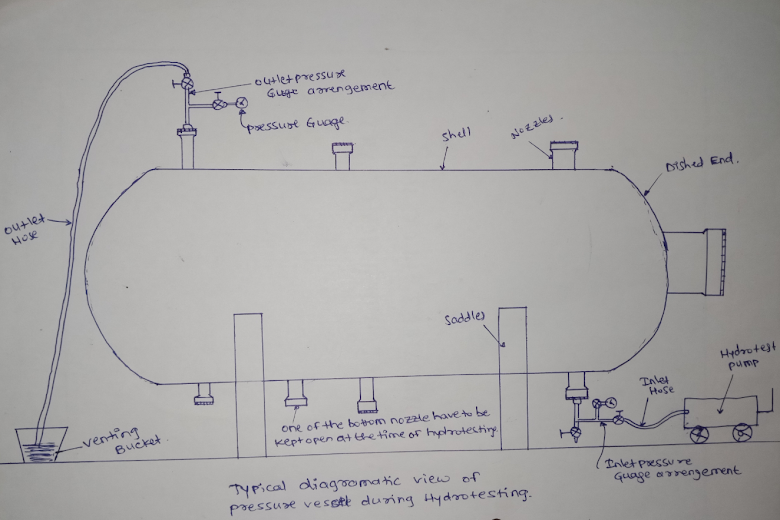HYDROSTATIC TESTING
Hydro-static testing is also called as hydro-test is the test in which
piping components, gas cylinders, storage tank, vessels etc is tested for the
leaks and strength of that component. The Hydro-static test is done after the
all activities like radiography of welding joints, required NDT, welding of all
pressure parts etc in order to the given object operate under desired
condition. This process in which the water filled in the component and
pressurised as per requirements of client which depend on service and other
factors.
The Typical Diagram for
pressure vessel during hydrostatic test shown below,
The hydro-static test is performed by firstly filling the components
such as tank, pipes etc with water after filling removing the air inside the
component and after that pumping or pressurized by pump up to pressure of that
component mentioned on engineering drawing . After pressurized at component
hold at specific pressure for specific amount of time which depend on clients
criteria or approved hydrostatic procedure from client after holding period the
all weld joints and whole component is inspected with help of lamp for tracing
of liquid to determine the crack and any kind of leaks.
Hydrostatic test is plays very important role in inspection. The
pressure at which hydrostatic test to be performed is as per design calculation
of that particular object but normally 4 times of design
pressure.
One thing is noted that the Hydrostatic testing is the non destructive
testing method which used for testing leaks and performance of that component.
Every testing consisting certain type of procedure and the testing is
done as per the procedure. The pressure at which the hydrostatic test to be
performed is given in the engineering drawing the pressure is measure by
pressure gauge and the gauge should be in service & calibrated condition up
to date. The range of pressure gauge is mentioned in appropriate procedure, as
per ASME section viii code the required ranging is 1.2 to 4 times for example if the
components hydro pressure 32 kg/cm2 then the minimum range of
pressure gauge as per code 1.2 that means 1.2 x 32 is 38.4 kg/cm2 and
maximum range that is 4 x 32 is 128 kg/cm2 that means the
pressure gauge to be used is in between the range from 38.4 to 128 kg/cm2 .
Different types of hydrostatic tests perform as per
components and as per requirement as Direct Expansion Method, Proof Pressure
Method, Water Jacket Method etc. But basic procedure is same. For example if we
performing the hydrostatic test of pressure vessels then the following points
must be consider in inspector point of view as,
1) Proper blanking of all Nozzles.
2) All Original blind flanges used Properly or not.
3) Completion of welding on pressure parts.
4) Vessel is kept on hydrotest saddles in the specified orientation as
per engineering drawings issued by design department.
5) Clearance of all pending NCR’S (Non Conformity Report) if any.
6) All Long Seams / Cir-seams are more visible for inspection.
7) Gaskets and gasket seats checked for any damages.
8) Inside surface properly clean or not.
9) Testing of PTC/MTC If any to the acceptable test results.
10) Check outside diameter circumference (ODCF) before pressurized, during pressurized and after release of pressure ODCF values is to
be reported.
11) All weld joints to be visually checked with lamp or
apply DPT testing on Weld joints.
12) Ensure that for original blinds the original fasteners
provided or not with required material grade and tightened to required torque
or not.
14) The water used is portable or other. (As per
procedure)
15) Measure the Metal temperature of vessel before Hydrostatic test.
16) Exact Ranging of pressure gauge is used or not.
) 17) Pressure gauges calibrated during the service and calibration certificate of calibration agency.
18) Arrangement for pressuring shall be through one of the nozzle for bottom.
19) Hydro Pump for pumping of water is available or not.
20) Inlet valve shall remain closed till water filling.
21) And most important parameter that is all activities like str Heat
treatments stress relieving (S.R.) if applicable is done or not, required NDT
performed or not in other word all required activities as per approved QAP.
After the hydrostatic test the Hydrostatic test Report is prepared as
per procedure the positioning of component, acceptance criteria, test
temperature, pressure application, type of inspection, rejection and
documentation all mentioned in approved procedure.
Acceptance Criteria.
For Section VIII Division 1 type
Pressure Vessels Reduce the test pressure above design pressure and inspect all
joints for leackage (As Per UG-99).
Design Pressure x 1.3 x Ratio of stress value of material at test temperature to Design Temperature.
For Section VIII Division 1 type
Pressure Vessels Reduce the test pressure above design pressure or 3/4th
Test pressure whichever is more and inspect all joints for leakage (As Per AT-355 & at-300 ).
Design Pressure x 1.25 x Ratio of stress value of material at test temperature to Design Temperature.
If any leakage
is observed from weld or parent metal or any joint, drain the water repair the
leak and reoffer for the hydrostatic testing.
If any leakage
observed through Gasket connection, depressurized the vessel and tighten the Stud/Nuts.
Arrangement of Inlet
pressure gauge & arrangement of Outlet pressure gauge as shown below,
Pic.02 : Arrangement of Inlet Pressure Gauge.
Safety points :
1) Drain
the water from vessel only when top outlet is kept open.
2) Never
pressurised vessel above required or mensioned pressure in given engineering drawings.
3) Use
minimum 2 pressure gauges for hydrotest.
4) Never use High discharge pumps for hydrotest.



ConversionConversion EmoticonEmoticon